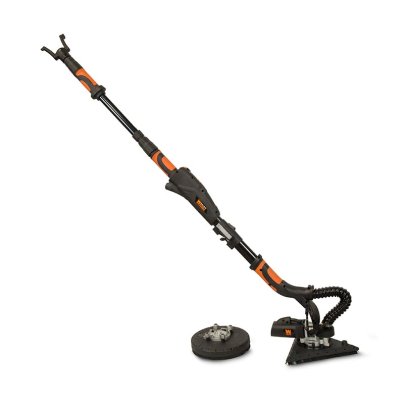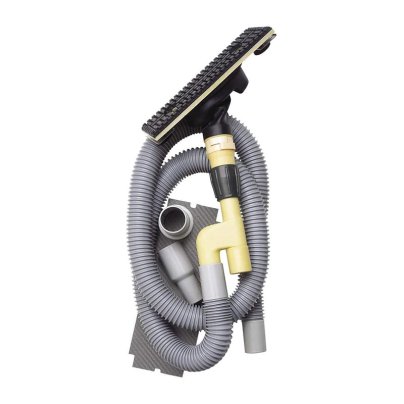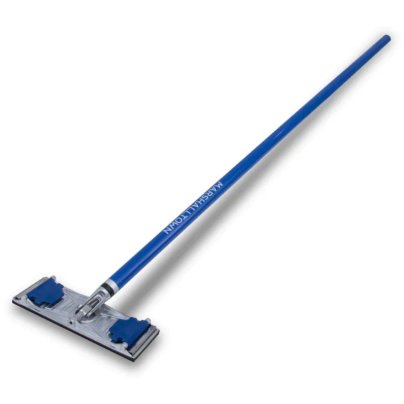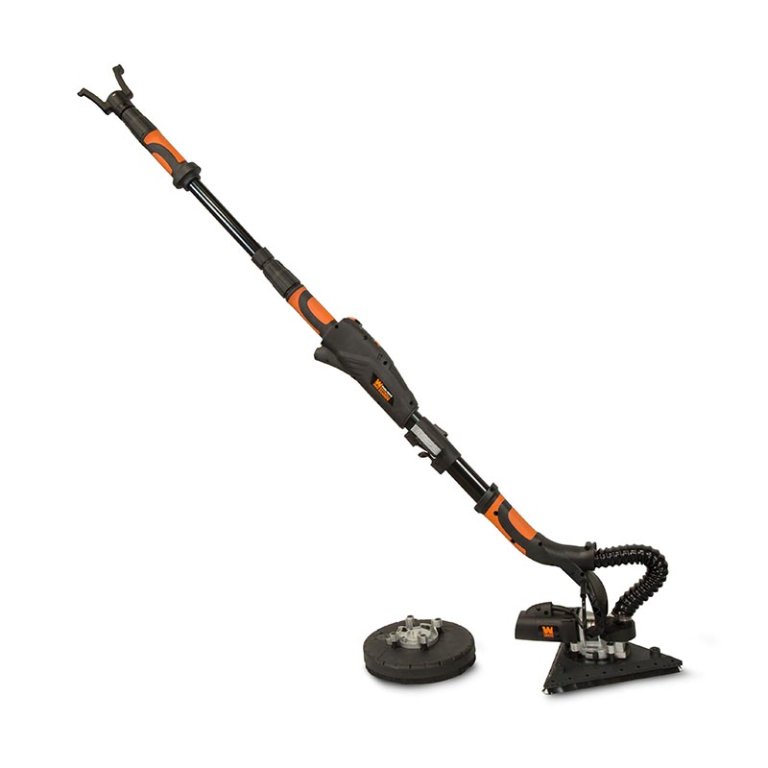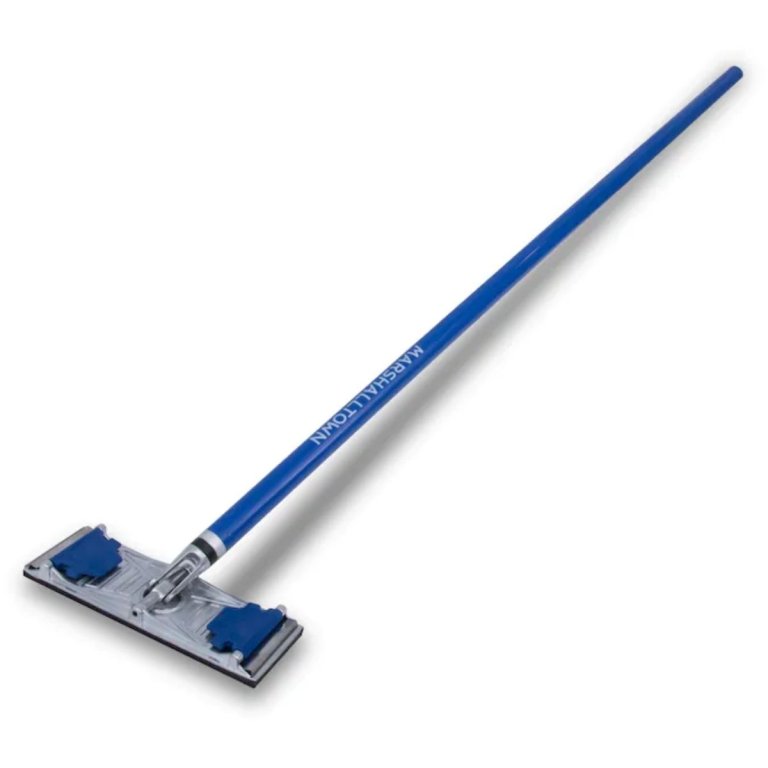
We may earn revenue from the products available on this page and participate in affiliate programs. Learn More ›
Drywall sanders help make the laborious process of preparing sheetrock for paint or plaster quicker and easier. These helpful tools are available as both manually powered pole sanders and options with high-speed motors that hook to convenient dust collection systems. To help you choose the version that’s right for your next DIY project, we put seven popular models through hands-on tests and reached out to a construction expert for additional insights.
Based on our efforts, we chose the Wen 6377 Variable-Speed Dual-Head Drywall Sander as the top sheetrock sander for its powerful corded construction, easy-to-maneuver design, and effective wet/dry dust collection hose. Still, a few of the other tools we tested are worth considering. Keep reading to learn more about all the products that won awards and get details on which features matter most when selecting from among the best drywall sanders.
- BEST OVERALL: Wen 6377 Variable-Speed Dual-Head Drywall Sander
↓ Jump to Review - BEST BANG FOR THE BUCK: Hyde 09170 Dust-Free Pole Sander Kit
↓ Jump to Review - BEST POLE SANDER: Marshalltown 48″ Pole Sander With Aluminum Handle
↓ Jump to Review - BEST CORDLESS: DeWalt 20V Max* Cordless Drywall Sander
↓ Jump to Review
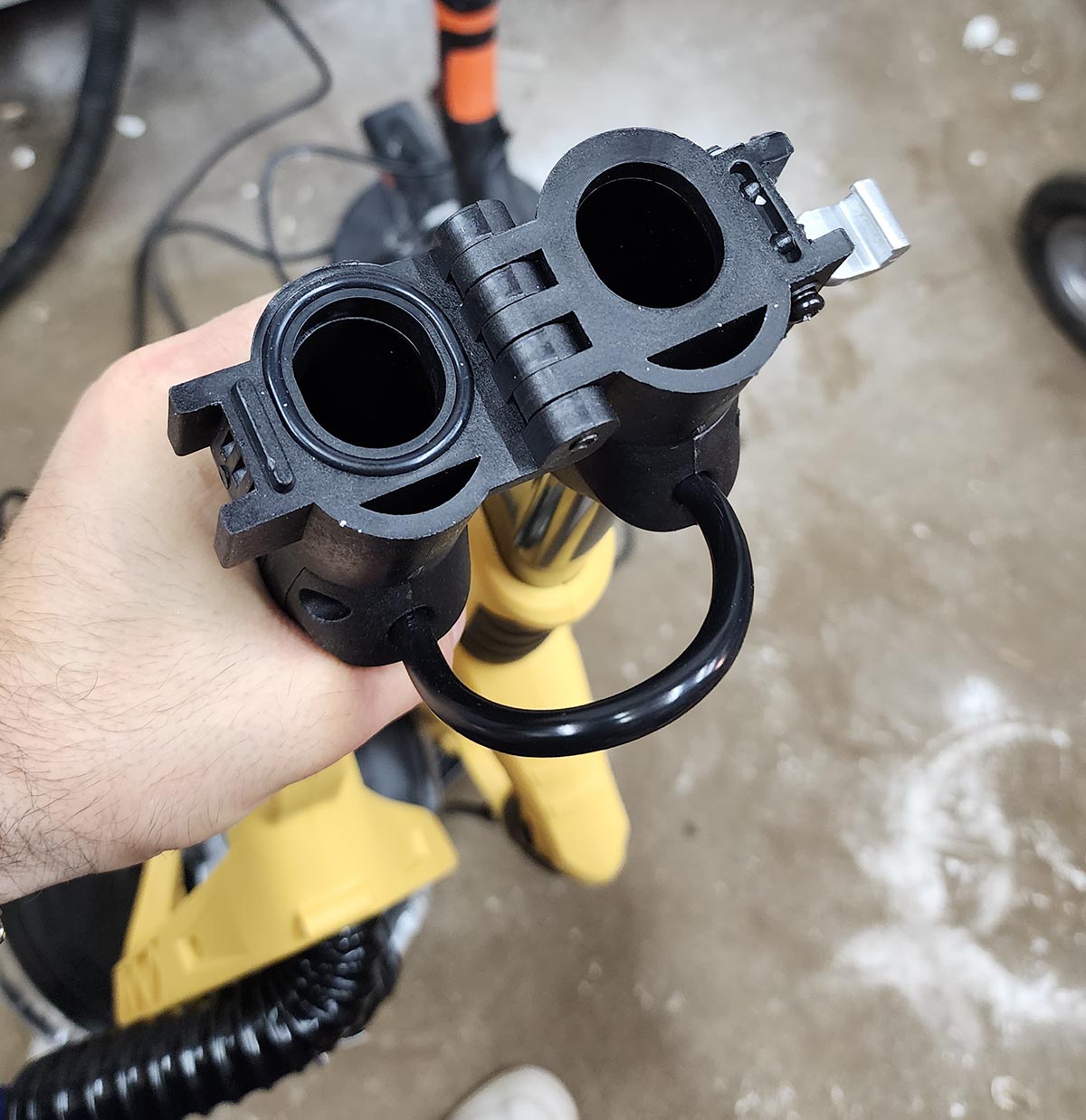
Best Drywall Sanders Comparison Chart
| Product Name | Type | Weight | Dust Collection |
| Wen 6377 Variable-Speed Dual-Head Drywall Sander | Corded electric | 17.4 pounds | Hose for wet/dry vac |
| Hyde 09170 Dust-Free Pole Sander Kit | Manual pole | 2.36 pounds | Hose for wet/dry vac |
| Marshalltown 48″ Pole Sander With Aluminum Handle | Manual pole | 1.6 pounds | None |
| DeWalt 20V Max* Cordless Drywall Sander | Cordless electric | 12.6 pounds | Hose connection (no hose included) |
Our Top Picks
The following products are our picks for the best drywall sanders available today. We suggest you compare each option closely before choosing the right ceiling sander on a pole or power drywall sander for your needs.
Best Overall
Wen 6377 Variable-Speed Dual-Head Drywall Sander
What We Like
- 2 sanding heads for bulk and detailed work
- Handle folds for storage and telescopes for tall spaces
- Adjustable shoulder strap makes it easier to handle
What We Don’t Like
- Doesn’t come with a dust bag
Specs
- Type: Corded electric
- Weight: 17.4 pounds
- Dust collection: Hose for wet/dry vac
The Wen 6377 drywall sanding vacuum is a corded electric model with a 5-amp head-mounted motor that pivots and swivels for easy sanding. It offers variable speeds between 600 and 1,500 revolutions per minute (RPM), making quick work of big projects. It comes with a standard 8.5-inch round head for large spaces and a triangular head to reach corners, and no tools are necessary to switch between the two.
We found we didn’t use the triangular head all that often in our tests, but having the option to do so is nice since hand-sounding corners with a block is the only alternative. When working on the ceiling, we appreciated the relatively light weight of this tool (just 9 pounds without one of the swappable heads attached) and the fact that the weight is fairly evenly distributed. The adjustable shoulder strap made using and carrying it even easier, and the 15-foot hose allowed us to get up high while remaining connected to our wet/dry vac. Still, it would be nice if this drywall sanding vacuum tool came with a bag. It does, however, come with a starter pack of sanding sheets that includes five of both round and triangle in grits of 60, 80, 120, 150, 180, and 240.
What our tester says: “The swappable heads are great, as the rotary head can do the bulk of the work while the triangle-shaped head gets into corners—plus, they’re very easy to change. We also really liked the telescoping and folding handle, which felt sturdy and secure during use but was easy to break down for storage.”—Tom Scalisi, Product Reviews tester and writer
Get the Wen drywall sander at Lowe’s, The Home Depot, or Wen.
Best Bang for the Buck
Hyde 09170 Dust-Free Pole Sander Kit
What We Like
- Comes with a vacuum hose and adapter
- Lightweight design enables extended use
- Head stays flat during use, which we prefer over those that flip
What We Don’t Like
- Doesn’t come with a pole
Specs
- Type: Manual pole
- Weight: 2.36 pounds
- Dust collection: Hose for wet/dry vac
Manual pole sanders offer a low-cost alternative to buying an electric sander machine for drywall, but their usual drawback (apart from the physical effort required) is that drywall dust gets everywhere. However, since the Hyde 09170 vacuum sander includes a hose attachment plus an adapter that fits most wet/dry vacs, it strikes an excellent balance between affordable and user-friendly.
Though this manual sander requires more physical input than a power option, we appreciated how much cleanup effort the hose saves us since it did such a good job collecting sanding dust. It even has adjustable vents that allow you to regulate the suction level to ensure you suck up as much dust as possible. We also liked that the swiveling head clamps to a sanding screen rather than using hook-and-loop abrasives and that the head remains flat during use instead of flipping over like many pole sanders do. Though this dust-free drywall sander kit comes with a washable, reusable screen, it doesn’t include a handle. It does have universal threads, however, so it will work with a standard broom or painter’s pole.
Get the Hyde drywall sander at Amazon, Ace Hardware, or Target.
Best Pole Sander
Marshalltown 48" Pole Sander With Aluminum Handle
What We Like
- Quick-clamp makes installing sanding screens easy
- No-flip swivel maneuvers without flipping
- Included pole is comfortable and durable
What We Don’t Like
- Pole is double female and won’t fit other tools
Specs
- Type: Manual pole
- Weight: 1.6 pounds
- Dust collection: None
A manual pole sander is a cheap and efficient solution for those on a tight budget or with only a modest amount of drywall to sand. While it doesn’t have a dust collection system like the other manual sander we recommend, we like that this model comes with a lightweight aluminum pole, which many rivals omit. It also has a reinforced cast aluminum head that’s lightweight and maneuverable yet doesn’t flex. In our tests, the free-swiveling head easily kept the abrasive flat against the wall instead of flipping over and marring the compound.
Since we’ve used this type of drywall pole sander for years, we feel like we know a quality tool when we see one, and our tests proved our instincts were correct. We loved that this model uses durable sanding screens instead of lower-quality sanding discs and that its quick-action clamps make sanding head replacement incredibly easy. We also really liked the aluminum construction and smooth paint finish of the included pole, which is so nice that we’d like to use it with other tools. Unfortunately, we can’t because both ends are female threads (one universal, one machine), so it won’t work with other pole-mounted tools.
Get the Marshalltown pole sander at Amazon.
Best Cordless
DeWalt 20V Max* Cordless Drywall Sander
What We Like
- Cordless design removes tripping hazard of cord
- Quick-release length adjustment is easy to use
- Has a wireless on/off switch for compatible dust collectors
What We Don’t Like
- Weight and large tube make use awkward at times
Specs
- Type: Cordless electric
- Weight: 12.6 pounds
- Dust collection: NoneHose connection (no hose included)
No power? No problem. The DeWalt cordless drywall sander offers you the ability to work in locations where no electricity is available. The 20-volt brushless motor delivers competitive power, driving the 9-inch head at speeds from 700 to 1,200 RPM. It also features a wireless on/off control when paired with a compatible dust collector.
There was a lot to like about this model during testing. The lack of a cord is a serious plus, and we found sanding a ceiling much easier without worrying about tripping. To be fair, we did still have to watch out for the vacuum hose, but that’s worth it since it eliminates so much mess. On the flip side, the 5-amp-hour battery only lasts about 30 minutes, so many users will need to invest in a second battery to avoid constant interruptions to recharge. The tool also felt heavier than 12.6 pounds, but that could be because the tube, which doubles as a handle, is a bit wide, which is not the most ergonomic design.
What our tester says: “We really liked this unit’s quick-release clamp, which made it easy to adjust the sander’s length. We noticed we could go from walls to ceilings much quicker with this model than with those where you have to unscrew clamps and screw them back down again.”—Tom Scalisi, Product Reviews tester and writer
Get the DeWalt drywall sander (tool only) at Amazon, Lowe’s, Ace Hardware, or The Home Depot (with batteries and charger).
ALSO TESTED
The high-speed, cable-driven F2C Variable-Speed Electric Drywall Sander has pretty decent user reviews, and we assumed we’d agree when we first started testing. However, the cable created excessive tension on the front of the sanding pad that forced it into fresh compound, and the fact that the motor is in the handle meant its fan kept blowing dust everywhere. We agree with users that its speed and weight are great, but we still think much better options are available.
Jump to Our Top Picks
How We Tested the Best Drywall Sanders
To ensure the drywall sanders we included in this guide can handle typical household tasks, we called upon our many years of experience with power tools, hand tools, and DIY projects. We selected seven top-rated sanders and used each for several days, completing drywall repair and working on a test wall and ceiling.
Since we’re also familiar with how to sand drywall, we used our knowledge to rate each option on speed, comfort, performance, and dust collection. We removed the sanders that failed our tests from our list and gave awards to the remaining picks based on their strengths.
What to Consider When Choosing a Drywall Sander
Those who already own a sander might wonder whether a dedicated drywall sander is really necessary. While random orbital or detail sanders might be enough for small areas, trying to sand a whole room with one gets old quickly. Knowing which features to look for before using a manual or power sander on drywall will help you choose the right tool for the job.
Types of Drywall Sanders
While you can find manual sanding blocks in any hardware store, their small size and the physical effort required to use them make them impractical for sanding drywall. The most basic alternative is a larger pad attached to a pole. Not surprisingly, these types of sanders are called pole sanders. Their heads can be oblong or round and usually attach to a hook-and-loop sanding disc or sanding screen. Advanced versions incorporate a hose you can attach to a wet/dry vac.
The other option is an eclectic sander, either a portable cable sander or a cordless version that’s handheld or attached to a pole. These are effectively large-diameter orbital drywall sanders, and they usually hook up to a wet/dry vac or have their own dust-collection system. A self-contained dustless drywall sander is a rapid way to finish drywall and dramatically reduces cleanup time.
Motor Power and Speed
Electric drywall vacuum sanders allow DIYers and professionals to work faster. Since their heads vary from 7 inches to 9 inches, these tools must have a reasonably powerful motor to drive them efficiently. A 5-amp motor should be enough, but those with bigger projects may want to look for a 7-amp model.
Cordless models are rated in volts, which reflects the battery power, and most of the models currently available are 20 volts. The Ah capacity of the battery is another important element. The higher the number, the longer the tool can run without needing recharging. Pay attention when buying a cordless sander, as many are sold “bare.” While the price might look attractive, the battery and the charger cost extra.
Electric drywall sanders also offer variable speeds, improving control for rapid material removal or fine finishing. The specifics will vary depending on the model, but the tools we considered ran between 500 and 2,000 RPM.
Flexibility, Hose Length, and Weight
Sanding drywall usually involves working up from the floor to the ceiling and possibly across the ceiling surface. The reach provided by the drywall sander has a major impact on convenience. Handheld electric models—much like an orbital sander for drywall but with a larger head—are often more affordable than long-reach versions, but you’ll need a ladder to reach the top of walls.
Low-cost manual pole sanders can offer good reach and have articulated joints that allow for multiple sanding angles. However, they may not come with a pole. Some manual sanders have dust collection, but you’ll still want to check that the included hose is long enough to reach your wet/dry vac. If the hose is on the short side, you’ll need to keep the collecting bag or vacuum close, meaning it could get in the way.
Weight also is an important factor since most electric models have head-mounted motors. A heavy tool will prove tiring, particularly if you need to use the drywall sander above shoulder height for extended periods. Some vacuum bags have shoulder straps to overcome this problem.
Sanding Discs and Screens
Many drywall sanders use inexpensive and easy-to-change hook-and-loop discs. These come in a range of grits, from 60 grit for fast material removal to 220 grit for final finishing before painting. The challenge with standard sanding discs is that the disc can clog quickly, even on drywall sanders with dust collection.
Sanding screens are an alternative that can fit some tools. The mesh screen is resistant to tearing and doesn’t clog as easily. Many can be rinsed and reused, whereas discs are usually disposable. There is a wide range of sanding screens available for rectangular pole sanders, which attach via clamps or clips. It can be difficult, however, to find screens for 9-inch-diameter heads that take hook-and-loop discs.
FAQs
While the technical information above may have answered many of your questions on the best drywall sanders, it’s possible you still have a few lingering queries. The following answers to frequently asked questions should help.
For small repairs, such as patching after removing drywall screws, finishing sanders can do a reasonable job. If you have a particularly thick area of compound you need to remove, even handheld belt sanders can be useful. But if you’re working on a large area or multiple rooms, getting a drywall sander will be worth it. Drywall sanding tools generally have long handles so you can work on walls and ceilings, and they offer much better dust control to minimize the mess created by this task.
Yes, you can use a good hand sander on drywall, however, the job will take considerably longer and likely be much dustier.
It is advisable to wear noise protection when using a drywall sanding machine since noise levels above 80 decibels (dB) may cause hearing loss. In workplaces, the Occupational Safety and Health Administration (OSHA) requires hearing protection for those experiencing sound levels above an average of 85dB for an 8-hour day. Many drywall sanders are around this level, but even quieter, prolonged exposure can be uncomfortable.
Yes. According to the Centers for Disease Control and Prevention, drywall dust can cause eye, nose, throat, and respiratory tract irritation. Prolonged exposure can lead to coughing, phlegm production, and breathing difficulties. Using some kind of mask while sanding is vital, and we recommend a half-mask respirator with replaceable filters.
Drywall dust is very fine and flies everywhere. Dampening it with a water spray helps it stick together, making it easier to clean up. Any spray bottle that produces a reasonably fine mist will do. Lightly spray the dust to make it damp (not wet), use a soft broom to sweep up as much as possible, and then vacuum. Drywall dust can easily clog household vacuums, so it’s best to use a wet/dry vac.
We asked Clark Lowe, President and CEO of O’Connor Company, which grits he recommends. He said, “For drywall, start with a medium grit like 120 to smooth rough edges, then finish with a finer grit like 180 or 220 for a polished surface.”
Mess- and dust-free sanding is easiest using the right tools and techniques. Cover open doorways with plastic sheeting, spread a drop cloth over floors, and select a drywall sander with a vacuum attachment to clear away dust as you go.
Building expert Clark Lowe says that “Drywall compound should be left to dry for at least 24 hours, depending on the thickness of the application and room conditions like humidity and ventilation.”
Meet the Tester
Tom Scalisi is a full-time DIY and construction writer for many of the largest websites in the industry, including BobVila.com, This Old House, Family Handyman, and Forbes. He spent years working in the trades and industrial maintenance, undertaking more drywall projects than he can count.
Additional research provided by Bob Beacham.
